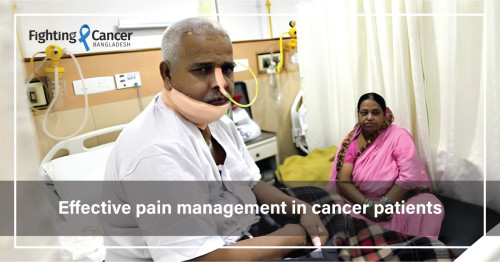
Pain is a common experience for many cancer patients, ranging from mild to severe. It could be for a short time or long-lasting. The pain can range from mild to unbearable. Pain may also persist after recovery for some individuals.
Cancer pain is a result of the effects of cancer on the body. When a tumor presses on nerves or body organs, or a cancer cell invades bone, cancer pain occurs in a patient. The pain varies from mild to severe based on the area of the body. A small tumor near a nerve is more painful than a large tumor in any other part of the body. Pain may also be a side effect of treatments such as chemotherapy, radiation, or surgery.
Cancer pain cannot always be relieved completely, but some medications and methods may lessen or control the pain. If any cancer patient feels pain, they should immediately inform the doctor. Pain management may improve the quality of life of a cancer patient.
The scenario of pain varies from cancer patient to patient. Cancer patients in the hospital are screened regularly and asked every four hours if they are feeling any pain in their bodies. Patients at home should promptly inform their doctor or care team if they experience pain.
The pain of a cancer patient is assessed on a scale of zero to ten. A pain score of zero indicates no pain. Let’s have a look at how cancer pain can be managed.
Surgery or radiation therapy
Surgery and radiation therapy are suggested to reduce pain along with other symptoms of cancer. These treatments offer comfort to advanced-stage cancer patients with tumors affecting the spinal cord or nerves.
Medications
- Mild to moderate pain
Cancer patients use non-opioid drugs (acetaminophen) and nonsteroidal anti-inflammatory drugs (aspirin, ibuprofen) to treat their bone and muscle pain. - Moderate to severe pain
Opioids (morphine, fentanyl, codeine, oxycodone, hydromorphone, and methadone) and a combination of non-opioids and opioids are used. - Unbearable pain
A quick-acting pain reliever like oral morphine is prescribed.
Nerve blocks
Nerve blocks are used by doctors to alleviate pain in a specific area. In most cases, ethyl alcohol and phenol are injected into a nerve or spinal cord, which interrupts the transmission of pain signals to the brain. This is given for acute and postoperative pain, and this blocking has a long-lasting effect.
Epidural and intrathecal pumps
These are suggested when cancer pain has a widespread effect. A patch is placed under the skin and releases medicine continuously over time, relieving pain in a large area of the body. Ziconotide is commonly used.
Neurosurgical approaches
When drug therapy fails or its side effects are hazardous, neurosurgery is suggested. This process is called cordotomy. It blocks the nerve in the spinal cord so that pain impulses are not transmitted to the brain.
Complementary therapies
At any stage of cancer treatment, complementary therapies can be incorporated. It includes relaxation techniques, meditation, acupuncture, massage, and movement therapies. These therapies can alleviate specific types of acute and chronic pain in individuals with cancer.

